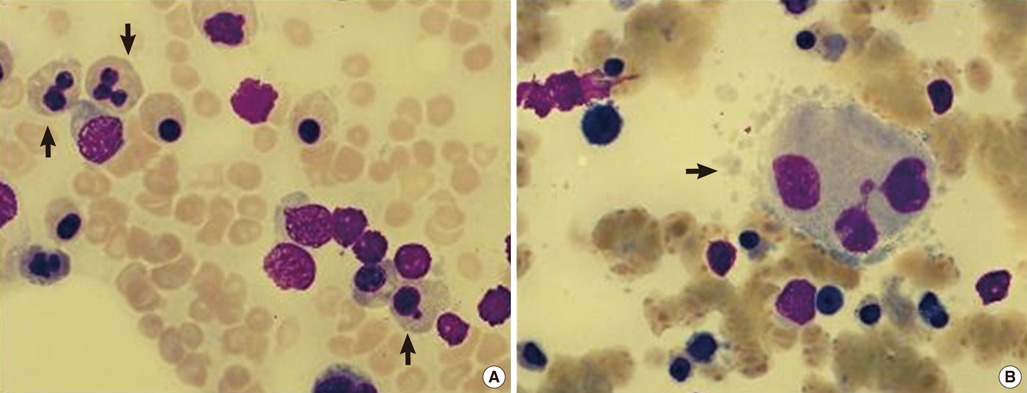Ann Lab Med.
2012 Jul;32(4):294-297. 10.3343/alm.2012.32.4.294.
A Case of Near-triploidy in Myelodysplastic Syndrome with del(5q) Combined with del(1p) and del(13q)
- Affiliations
-
- 1Department of Laboratory Medicine, Dong-A University College of Medicine, Busan, Korea. jyhan@dau.ac.kr
- 2Department of Internal Medicine, Dong-A University College of Medicine, Busan, Korea.
- 3Signature Genomic Laboratories, Spokane, WA, USA.
- KMID: 1380090
- DOI: http://doi.org/10.3343/alm.2012.32.4.294
Abstract
- Numerical and structural chromosomal abnormalities are common in hematological malignancies. Near-triploidy (58-80 chromosomes) is a numerical abnormality observed in 3% of adult cases of acute lymphoblastic leukemia. Near-triploidy is rare in myeloid lineage hematologic malignancies and compared to near-triploidy in lymphoid malignancies, near-triploidy in myeloid malignancies is associated with poor outcomes. Few studies on near-triploidy in myelodysplastic syndrome (MDS) have been reported, and the clinicopathologic significance of this condition is still unclear. Here, we report a novel case of MDS with near-triploidy and multiple structural chromosomal abnormalities: del(5q) combined with del(1p) and del(13q). These abnormalities were detected by cytogenetic analysis with array comparative genomic hybridization (CGH). Our results suggest that array CGH can be a useful tool for detecting chromosomal abnormalities in patients with MDS.
Keyword
MeSH Terms
Figure
Reference
-
1. Sabattini E, Bacci F, Sagramoso C, Pileri SA. WHO classification of tumours of haematopoietic and lymphoid tissues. Pathologica. 2010. 102:83–87.2. Solé F, Luño E, Sanzo C, Espinet B, Sanz GF, Cervera J, et al. Identification of novel cytogenetic markers with prognostic significance in a series of 968 patients with primary myelodysplastic syndromes. Haematologica. 2005. 90:1168–1178.3. Le Beau MM, Albain KS, Larson RA, Vardiman JW, Davis EM, Blough RR, et al. Clinical and cytogenetic correlations in 63 patients with therapy-related myelodysplastic syndromes and acute nonlymphocytic leukemia: further evidence for characteristic abnormalities of chromosomes no. 5 and 7. J Clin Oncol. 1986. 4:325–345.
Article4. Stamatoullas A, Callat MP, Marreiros S, Tilly H, Bastard C. Unusual complex hyperdiploid karyotypes in myelodysplastic syndromes. Cancer Genet Cytogenet. 2006. 170:129–132.
Article5. Iyer RV, Sait SN, Matsui S, Block AW, Barcos M, Slack JL, et al. Massive hyperdiploidy and tetraploidy in acute myelocytic leukemia and myelodysplastic syndrome. Cancer Genet Cytogenet. 2004. 148:29–34.
Article6. Lim G, Oh SH, Choi JR, Lee HJ, Suh JT, Yoon HJ, et al. Leukemic transformation associated with massive hyperdiploidy in myelodysplastic syndrome (MDS) with der(1;7)(q10;p10): a novel case study. Leuk Res. 2010. 34:e208–e209.
Article7. Znoyko I, Stuart RK, Ellingham T, Winters J, Wolff DJ, Quigley DI. Tetraploidy and 5q deletion in myelodysplastic syndrome: a case report. Cancer Genet Cytogenet. 2008. 183:64–68.
Article8. Acar H, Calişkan U U, Kaynak M, Yildirim MS, Largaespada DA. Hyperdiploid karyotype in a childhood MDS patient. Clin Lab Haematol. 2001. 23:255–258.
Article9. Manley R, Cochrane J, Patton WN. Polyploidy in myelodysplastic syndrome: a case report. Cancer Genet Cytogenet. 1998. 106:170–172.10. Tanaka M, Takeuchi H, Kaku K, Oka Y. Myelodysplastic syndrome associated with hypotriploidy. Acta Haematol. 1996. 95:148–150.
Article11. Bacher U, Haferlach T, Kern W, Weiss T, Schnittger S, Haferlach C. The impact of cytomorphology, cytogenetics, molecular genetics, and immunophenotyping in a comprehensive diagnostic workup of myelodysplastic syndromes. Cancer. 2009. 115:4524–4532.
Article12. Kawankar N, Vundinti BR. Cytogenetic abnormalities in myelodysplastic syndrome: an overview. Hematology. 2011. 16:131–138.
Article13. Shaffer LG, Slovak MI, Campbell LJ, editors. An International System for Human Cytogenetic Nomenclature (ISCN). 2009. Basel: S, Karger;36–84.14. Hu J, Gao JB, Cao Y, Bottinger E, Zhang W. Exploiting noise in array CGH data to improve detection of DNA copy number change. Nucleic Acids Res. 2007. 35:e35.
Article15. Watanabe A, Inokuchi K, Yamaguchi H, Mizuki T, Tanosaki S, Shimada T, et al. Near-triploidy and near-tetraploidy in hematological malignancies and mutation of the p53 gene. Clin Lab Haematol. 2004. 26:25–30.
Article16. Sheth FJ, Sheth JJ, Desai C. Case of near triploidy with i(17)(q10) in blast crisis CML. Cancer Genet Cytogenet. 2006. 164:177–178.
Article17. Roland B. A case of near-triploidy in chronic myelogenous leukemia. Cancer Genet Cytogenet. 2000. 121:96–98.
Article18. Mallo M, Cervera J, Schanz J, Such E, García-Manero G, Luño E, et al. Impact of adjunct cytogenetic abnormalities for prognostic stratification in patients with myelodysplastic syndrome and deletion 5q. Leukemia. 2011. 25:110–120.
Article19. Lee HR, Oh B, Hong DS, Zang DY, Yoon HJ, Kim HJ, et al. Cytogenetic features of 5q deletion and 5q- syndrome in myelodysplastic syndrome in Korea; marker chromosomes proved to be chromosome 5 with interstitial deletion by fluorescence in situ hybridization. Cancer Genet Cytogenet. 2010. 203:193–202.
Article20. Martínez-Ramírez A, Urioste M, Melchor L, Blesa D, Valle L, de Andrés SA, et al. Analysis of myelodysplastic syndromes with complex karyotypes by high-resolution comparative genomic hybridization and subtelomeric CGH array. Genes Chromosomes Cancer. 2005. 42:287–298.
Article21. Praulich I, Tauscher M, Göhring G, Glaser S, Hofmann W, Feurstein S, et al. Clonal heterogeneity in childhood myelodysplastic syndromes-challenge for the detection of chromosomal imbalances by array-CGH. Genes Chromosomes Cancer. 2010. 49:885–900.
Article
- Full Text Links
- Actions
-
Cited
- CITED
-
- Close
- Share
- Similar articles
-
- A Case of Myelodysplastic Syndrome Associated with an Isolated del(5q) Chromosomal Abnormality Showing Poor Prognosis
- Lenalidomide for the Treatment of Myelodysplastic Syndrome
- Del(5q) myelodysplastic syndrome combined with pure red cell aplasia
- Significance of cytogenetics in myelodysplastic syndromes
- A New Allelic Variant in the PANK2 Gene in a Patient with Incomplete HARP Syndrome



